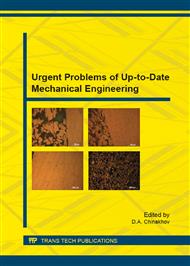[1]
J.B. Pendry, D. Shurig, D.R. Smith, Controlling electromagnetic fields, J. Science. 312 (2006) 1780-1789.
Google Scholar
[2]
A.E. Dubinov, L.A. Mytareva, Invisible cloaking of material bodies using the wave flow method, J. Phys. Usp. 53 (2010) 455-479.
DOI: 10.3367/ufne.0180.201005b.0475
Google Scholar
[3]
H. Liu, T. Zhou, Transformation optics and approximate cloaking, J. Contemp. Math. 559 (2011) 65-83.
Google Scholar
[4]
H. Liu, T. Zhou, Two dimensional invisibility cloaking via transformation optics, J. Disc. Cont. Dyn. Syst. Ser. A. 31 (2011) 526-543.
Google Scholar
[5]
D.S. Anikonov, V.G. Nazarov, I.V. Prokhorov, Visible and invisible media in tomography, J. Dokl. Math. 56 (1997) 955-958.
Google Scholar
[6]
D.S. Anikonov, I.V. Prokhorov, Necessary and sufficient conditions for the uniqueness of a solution to a tomography problem, J. Comput. Math. Math. Phys. 42 (2002) 370-379.
Google Scholar
[7]
G.V. Alekseev, Optimization in problems of material-body cloaking using the wave-flow method, J. Dokl. Phys. 58 (2013) 147-151.
DOI: 10.1134/s1028335813040071
Google Scholar
[8]
G.V. Alekseev, Control of boundary impedance in two-dimensional material-body cloaking the wave flow method, J. Comp. Math. and Math. Phys. 53 (2013) 1853-1869.
DOI: 10.1134/s0965542513120014
Google Scholar
[9]
G.V. Alekseev, A.V. Lobanov, Stability estimates for the solution to inverse extremal problems for the Helmholtz equation, J. Appl. Ind. Math. 7 (2013) 1-13.
DOI: 10.1134/s1990478913030034
Google Scholar
[10]
G.V. Alekseev, Cloaking of material objects by controlling the impedance boundary condition for Maxwell's equations, J. Dokl. Phys. 58 (2013) 482-486.
DOI: 10.1134/s1028335813110025
Google Scholar
[11]
G.V. Alekseev, Cloaking via impedance boundary condition for 2-D Helmholtz equation, J. Appl. Anal. 93 (2014) 254-268.
DOI: 10.1080/00036811.2013.768340
Google Scholar
[12]
G.V. Alekseev, Levin V. A, Optimization method of searching parameters of an inhomoge-neous liquid medium in the acoustic cloaking problem, J. Dokl. Phys. 59 (2014) 89-93.
DOI: 10.1134/s1028335814020013
Google Scholar
[13]
G.V. Alekseev, Stability estimates in the problem of cloaking material bodies for Maxwell's equations, J. Comp. Math. and Math. Phys. 54 (2014) 1788-1803.
DOI: 10.1134/s0965542514120069
Google Scholar
[14]
G.V. Alekseev, A.V. Lobanov, V. Sosnov, Control approach in cloaking problems for 2-D model of sound scattering, J. Appl. Mech. and Mater. 635-637 (2014) 13-16.
DOI: 10.4028/www.scientific.net/amm.635-637.13
Google Scholar
[15]
Yu. Yu. Fershalov, Technique for physical simulation of gasodynamics processes in the turbomachine flow passages, J. Russ. Aeron. 55 (2012) 424-429.
DOI: 10.3103/s1068799812040186
Google Scholar
[16]
Ju. Yu. Fershalov, T.V. Sazonov, Experimental research of the nozzles, J. Advan. Mater. Res. 915-916 (2014) 345-348.
DOI: 10.4028/www.scientific.net/amr.915-916.345
Google Scholar
[17]
M. Yu. Fershalov, A. Yu. Fershalov, Yu. Ya. Fershalov Calculation of reactivity degree for axial lowaccount turbines with small emergence angles on nozzle devices. J. Advan. Mater. Res. 915-916 (2014) 341-343.
DOI: 10.4028/www.scientific.net/amr.915-916.341
Google Scholar


